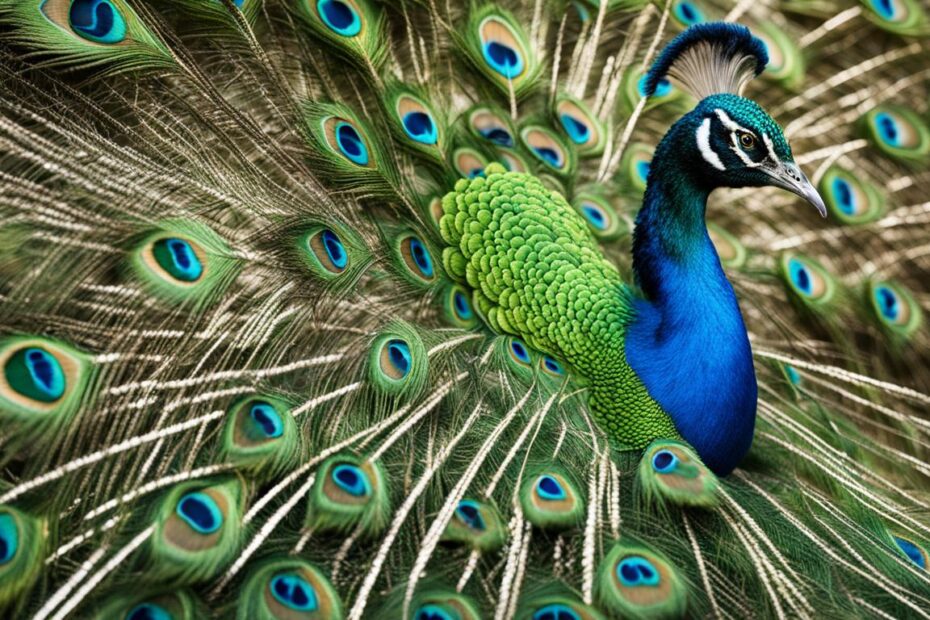Baby male peacocks are fascinating creatures with vibrant beauty and unique behaviors. In this article, we will explore the growth process of a baby male peacock and uncover the secrets of their stunning feathers and colors. Get ready for an enlightening journey into the captivating world of these majestic birds.
Key Takeaways:
- Baby male peacocks are known for their vibrant feathers and unique behaviors.
- Peacock feathers have a mesmerizing array of colors due to light interference.
- The growth process of a baby male peacock involves molting and takes about three years.
- Peacocks exhibit striking courtship displays and vocalizations.
- Peacocks hold cultural significance and inspire various art forms.
The Beauty of Peacock Feathers
Peacock feathers are renowned for their mesmerizing beauty and striking colors. The intricate patterns and vibrant hues of blue, green, and gold make them one of the most sought-after feathers in the world. These feathers have a unique structure that creates their brilliant iridescence, reflecting light and creating a shimmering effect. The distinct coloration of peacock feathers is a result of light interference caused by the microscopic structures within the feather. This natural phenomenon gives the feathers their stunning array of colors, making them truly captivating.
Peacock feathers have long been admired for their ornamental value and have been used throughout history in various cultural and artistic contexts. They have adorned royal garments, decorative accessories, and even religious artifacts. The unique colors and patterns of peacock feathers make them highly desirable for fashion designers, interior decorators, and artists seeking inspiration.
Furthermore, peacock feathers hold symbolic meaning in many cultures. They are often associated with qualities such as beauty, power, and immortality. In Hinduism, for example, the peacock is considered a sacred bird and is believed to represent integrity and spiritual awakening. In ancient Greek mythology, the peacock was associated with the goddess Hera and was seen as a symbol of her watchfulness.
Table: The Vibrant Colors of Peacock Feathers
| Color | Description |
|---|---|
| Blue | The blue color in peacock feathers is caused by the microscopic structures that reflect and scatter light, creating a vibrant blue hue. |
| Green | The green color in peacock feathers is a result of the combination of blue and yellow pigments, giving them a rich and lustrous appearance. |
| Gold | The gold color in peacock feathers is achieved through a mix of yellow and brown pigments, adding warmth and depth to the overall color scheme. |
The Growth Process of a Baby Male Peacock
A baby male peacock goes through an incredible growth process, transforming from a small hatchling into a magnificent adult with vibrant feathers. Let’s take a closer look at the stages of this remarkable journey:
Egg Hatching
The growth process begins when the peacock chick hatches from its egg, which takes approximately 28 days. During this time, the chick develops inside the egg, absorbing the necessary nutrients from the yolk. Once hatched, the chick emerges covered in soft down feathers, which provide warmth and protection.
Molting and Feather Development
As the baby peacock grows, it goes through several molting stages. During these periods, the chick sheds its down feathers and replaces them with new ones. This molting process allows the feathers to grow and develop, gradually revealing the stunning colors and patterns that peacocks are known for.
Full Maturity
It takes about three years for a baby male peacock to fully develop its vibrant, iridescent feathers and reach maturity. During this time, the peacock’s feathers undergo further growth and transformation, becoming more vibrant and majestic with each molting stage. Once fully matured, the baby male peacock proudly displays its beautiful plumage, ready to attract a mate and establish its dominance.
Witnessing the growth of a baby male peacock is a truly awe-inspiring journey. From the hatching of the egg to the development of its vibrant feathers, these majestic birds captivate us with their natural beauty and resilience.
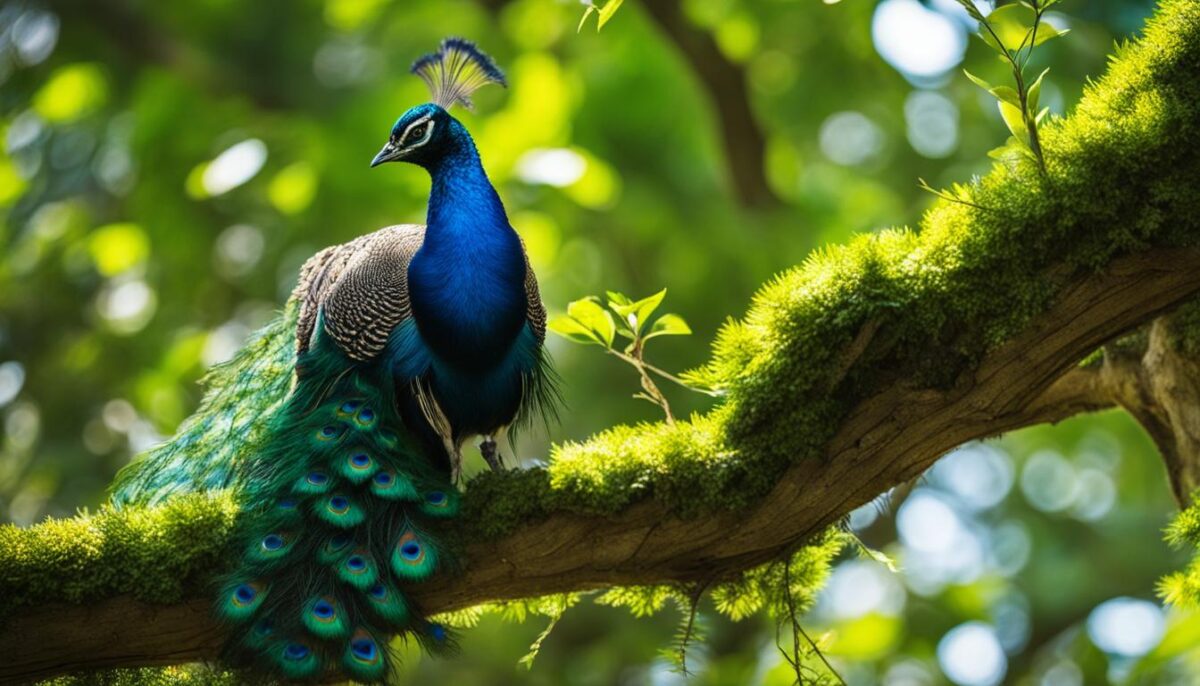
| Growth Stages | Duration |
|---|---|
| Egg Hatching | Approximately 28 days |
| Molting and Feather Development | Progressive stages over three years |
| Full Maturity | Reached after three years |
Unique Behaviors of a Baby Male Peacock
Baby male peacocks are not only known for their stunning feathers, but also for their unique behaviors that contribute to their charm. One of the most iconic behaviors is the extravagant courtship display, where the peacock fans out its tail feathers and performs a dazzling dance to attract a mate. This visual spectacle showcases the peacock’s beauty and grace, captivating both observers and potential mates alike.
Aside from their elaborate courtship displays, baby male peacocks are also known for their vocalizations. They have a wide range of calls, including cries, screams, and even songs. These vocalizations serve various purposes, such as establishing dominance, defending territory, and attracting females. The melodic tones and distinctive sounds of baby male peacocks create an enchanting atmosphere in their surroundings.
In addition to their courtship displays and vocalizations, baby male peacocks exhibit other fascinating behaviors. They are highly territorial and will vigorously defend their territory from intruders. Their defensive displays can include fanning out their feathers, raising their crest, and making aggressive postures. These behaviors demonstrate their instinctive need to protect their space and assert dominance in their environment.
| Behaviors of Baby Male Peacocks | Description |
|---|---|
| Courtship Display | An extravagant dance and tail feather fanning to attract mates. |
| Vocalizations | A wide range of calls, including cries, screams, and songs. |
| Territorial Defense | Fanning out feathers, raising crest, and making aggressive postures to protect their territory. |
These unique behaviors of baby male peacocks add to their allure and make them truly captivating creatures to observe. Whether it’s their mesmerizing courtship displays, melodic vocalizations, or assertive territorial defense, these behaviors showcase their natural instincts and contribute to their remarkable beauty.
Peacock Symbolism and Meaning
Peacocks have deep symbolic meanings in various cultures and belief systems. They are often associated with beauty, prosperity, protection, and renewal. In Hinduism, the peacock is considered a sacred bird and is associated with the goddess Saraswati, who represents knowledge, wisdom, and creativity. In Christianity, the peacock is a symbol of resurrection and immortality due to its annual shedding and regrowth of feathers. The peacock’s vibrant plumage and regal demeanor make it a powerful emblem of pride and confidence.
Peacocks have been revered and admired throughout history for their captivating beauty and majestic presence. They have held significant cultural and spiritual significance in various regions around the world.
In addition to their association with divinity, peacocks symbolize beauty, grace, and elegance. Their vibrant feathers and elaborate courtship displays have inspired artists, writers, and designers for centuries. The peacock’s symbolism extends beyond its physical attributes to represent qualities such as royalty, immortality, and rebirth.
Caring for a Baby Male Peacock
Proper care and attention are crucial when it comes to nurturing a baby male peacock. These magnificent creatures require specific care to ensure their health and well-being. Let’s explore the essential aspects of caring for a baby male peacock.
Dietary Requirements
A balanced diet is vital for the growth and development of a baby male peacock. Their diet should consist of a variety of fruits, vegetables, grains, and protein sources. This ensures they receive the necessary nutrients to thrive. It is important to provide fresh food daily and ensure they have access to clean, freshwater at all times.
Habitat and Environment
Creating a suitable habitat for a baby male peacock is essential. They require a spacious and secure enclosure where they can roam freely and display their natural behaviors. The habitat should have both sheltered areas and open spaces, allowing them to find shade and engage in activities such as foraging and exploring. Providing perches and branches will also give them opportunities to exercise and roost.
Healthcare and Veterinary Support
Regular veterinary check-ups are necessary to monitor the health of a baby male peacock. Vaccinations and preventive treatments for parasites should be administered as recommended by a veterinarian. Additionally, maintaining a clean environment and practicing good hygiene will help prevent the spread of diseases. It is essential to monitor the bird for any signs of illness or distress and seek professional help if needed.
| Aspect of Care | Key Considerations |
|---|---|
| Diet | Provide a balanced mix of fruits, vegetables, grains, and protein sources. Ensure access to clean, freshwater. |
| Habitat | Create a spacious and secure enclosure with sheltered areas, open spaces, perches, and branches. |
| Healthcare | Schedule regular veterinary check-ups, administer vaccinations and preventive treatments, maintain cleanliness, monitor for signs of illness or distress. |
By offering the proper care, nutrition, and environment, you can ensure a baby male peacock grows into a healthy and vibrant adult bird. Remember to provide them with the attention and love they deserve, and enjoy the beauty they bring to your life.
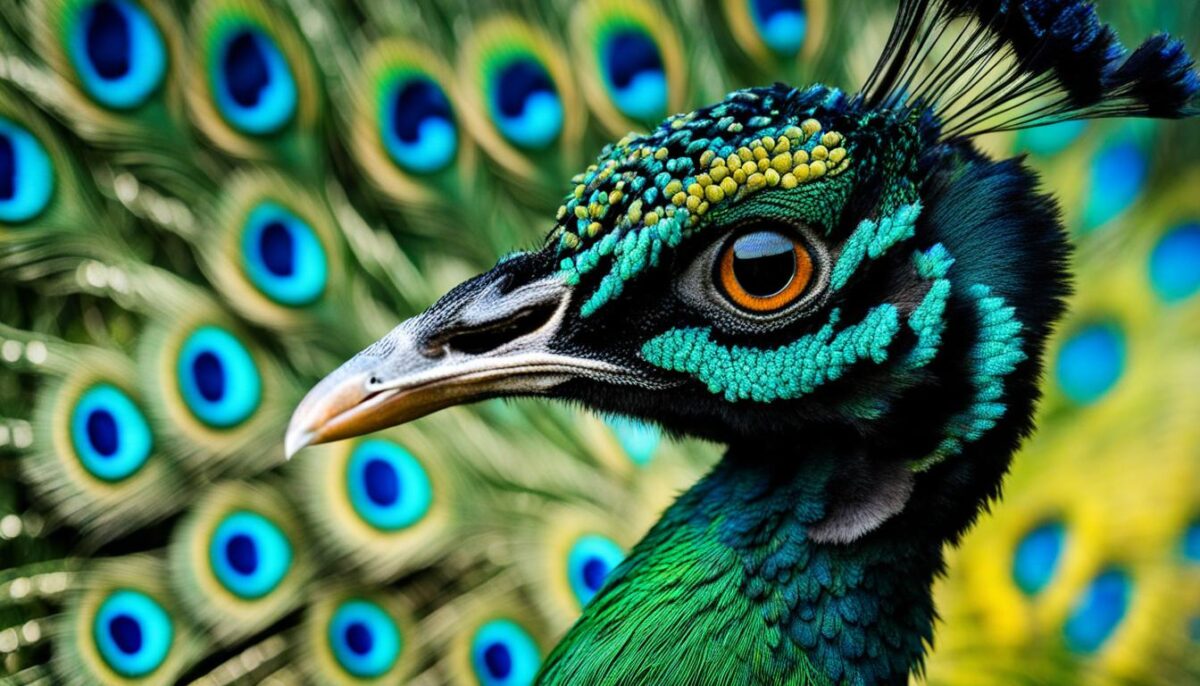
The Significance of Peacock Feathers in Culture and Art
Peacock feathers hold significant cultural and artistic value in many societies. They have been used as symbols of royalty, wealth, and beauty in various art forms, including paintings, sculptures, and fashion.
In Indian culture, peacock feathers are considered auspicious and are often used in religious ceremonies and rituals. Their vibrant colors and intricate patterns have also inspired fashion designers and decorators alike, adding a touch of elegance and opulence to their creations.
The symbolism of peacock feathers extends beyond their visual appeal. They represent qualities such as pride, immortality, and protection. In many ancient cultures, the peacock was associated with the gods and goddesses, symbolizing their divine qualities and connection to the spiritual realm.
The Use of Peacock Feathers in Art
Peacock feathers have been a popular motif in art throughout history. From ancient Egyptian artifacts to Renaissance paintings, artists have been captivated by the peacock’s beauty and incorporated it into their works.
In the words of renowned artist Gustav Klimt, “The eye-catching colors and patterns of peacock feathers inspire me to create art that celebrates the beauty and complexity of the natural world.”
The intricate patterns and vibrant hues of peacock feathers lend themselves well to various artistic techniques, including pointillism, mosaic, and textile design. Additionally, the feathers’ iridescent quality provides a dynamic element that changes with light, adding depth and visual interest to artworks.
Peacock Feathers in Cultural Symbolism
Peacock feathers have deep-rooted symbolism in many cultures. They are often associated with beauty, abundance, and good fortune. In Hinduism, peacock feathers are believed to bring luck and protect against negative energy.
Furthermore, peacock feathers have been used as decorative elements in traditional costumes, jewelry, and ceremonial headdresses in different parts of the world. Their inclusion in cultural celebrations and rituals reflects the reverence and respect for the majestic bird and its feathers’ symbolic significance.
| Peacock Feather Symbolism in Different Cultures | Symbolism |
|---|---|
| India | Divinity, spirituality, and good fortune |
| China | Peace, love, and compassion |
| Greece | Royalty, immortality, and protection |
| Christianity | Resurrection and eternal life |
Peacock feathers continue to inspire artists, designers, and individuals worldwide, serving as a reminder of the vibrant beauty and symbolism they hold. Whether adorning a painting, an elegant piece of jewelry, or a sacred offering, the allure of peacock feathers transcends time and cultural boundaries.
Fascinating Peacock Facts
| Fact 1 | Peacocks are the national bird of India. |
| Fact 2 | The male peacock is called a peacock, while the female is called a peahen. |
| Fact 3 | Peacocks can fly, despite their large and heavy tail feathers. |
| Fact 4 | The average lifespan of a peacock in the wild is about 20 years. |
| Fact 5 | Peacocks are omnivorous and eat a variety of foods, including seeds, insects, and small reptiles. |
| Fact 6 | Peacocks are highly territorial and will aggressively defend their territory from intruders. |
Peacocks are fascinating creatures with many intriguing facts. Let’s explore some of these fascinating peacock facts:
- Fact 1: Peacocks are the national bird of India. They hold great cultural and symbolic significance in Indian mythology and traditions.
- Fact 2: The male peacock is called a peacock, while the female is called a peahen. The extravagant feathers that we often associate with peacocks are actually only found in males.
- Fact 3: Despite their large and heavy tail feathers, peacocks can fly. They use their long feathers for display and courtship rituals, but they also possess strong flight muscles.
- Fact 4: In the wild, peacocks have an average lifespan of about 20 years. However, peacocks kept in captivity can live longer, with some reaching up to 30 years.
- Fact 5: Peacocks are omnivorous, meaning they eat both plants and animals. Their diet includes seeds, insects, small reptiles, and even small mammals.
- Fact 6: Peacocks are highly territorial birds and will fiercely defend their territory from intruders. They use their vibrant feathers and loud vocalizations to establish dominance and protect their space.
“Peacocks are nature’s living artwork, with their vibrant feathers and graceful demeanor. Their fascinating facts only add to their charm and allure.” – Anonymous
Peacock facts showcase the incredible diversity and uniqueness of these magnificent birds. From their symbolic significance to their incredible plumage, peacocks continue to captivate and inspire awe in people worldwide. Their beauty and elegance make them a true marvel of the natural world.
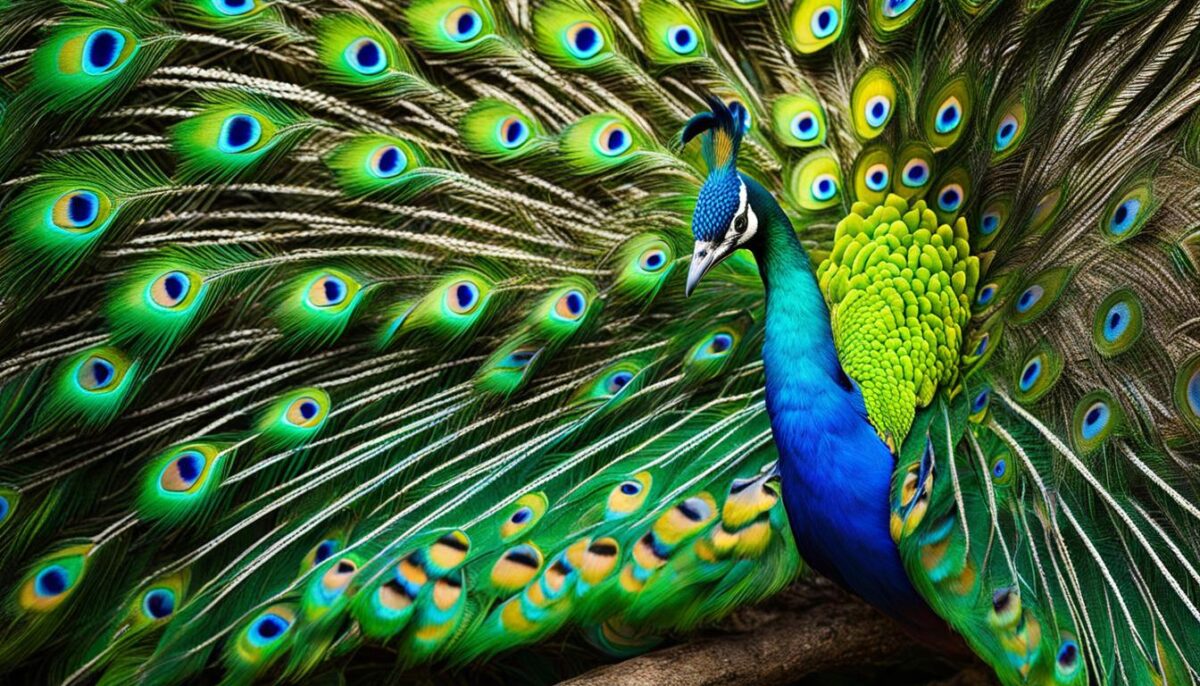
The Influence of Peacock Symbolism
The symbolism of peacocks in art and literature is profound and multi-faceted. They are often seen as symbols of beauty, grace, and elegance, embodying the human desire for perfection and self-expression. The vibrant colors of their feathers represent vitality and abundance, while their regal demeanor signifies power and nobility.
Furthermore, peacocks can also symbolize spiritual enlightenment and transcendence. In many cultures, they are associated with wisdom, resurrection, and immortality. The peacock’s ability to shed its feathers and regrow them anew serves as a metaphor for personal growth and transformation, inspiring individuals to embrace change and embrace their true potential.
The Significance of Peacocks in Mythology and Folklore
In addition to their role in art and literature, peacocks hold great significance in mythology and folklore. In ancient Greek and Roman mythology, the peacock was associated with the goddess Hera and symbolized immortality and royalty. In Hindu mythology, the peacock is the mount of Lord Kartikeya, the god of war, symbolizing strength and protection.
Peacocks are also deeply rooted in Eastern mythology and are considered sacred in many Asian cultures. In Chinese folklore, the peacock is believed to bring happiness, good fortune, and peace. In Japan, the peacock is associated with purity, and its feathers have been used in traditional rituals and ceremonies.
| Peacock Symbolism in Different Cultures | Symbolism |
|---|---|
| Indian Culture | Beauty, divinity, fertility |
| Chinese Culture | Love, compassion, good fortune |
| Greek Mythology | Immortality, royalty |
Maintaining a Respectful Approach to Peacocks and Their Habitat
As we immerse ourselves in the awe-inspiring beauty of peacocks, it is our responsibility to adopt a respectful approach towards these magnificent creatures and their natural habitat. Conservation efforts play a crucial role in safeguarding peacock populations and preserving their habitats from human encroachment. To contribute to peacock conservation, there are several measures we can take:
1. Avoid Disturbing or Feeding Wild Peacocks
While it may be tempting to approach or feed wild peacocks, it is important to remember that these birds have adapted to rely on their natural food sources. Feeding them human food can disrupt their natural behaviors and lead to a dependency that is harmful to their overall health. Additionally, approaching wild peacocks can cause stress and fear, causing them to retreat or abandon their habitats.
2. Respect Nesting Areas
Peacocks build their nests in specific locations to protect their eggs and ensure the survival of future generations. It is essential to respect these nesting areas and avoid any disturbances that may cause harm or abandonment. Keep a safe distance and observe from afar to admire these natural wonders without causing unnecessary stress or harm.
3. Support Local Conservation Efforts
Get involved in local initiatives and organizations that focus on peacock conservation. By supporting these efforts, you contribute to the preservation of peacock habitats, research, and education. Whether through donations, volunteering, or spreading awareness, every contribution counts and helps ensure the long-term survival of these incredible birds.
By maintaining a respectful approach to peacocks and their habitat, we can help ensure their continued presence for generations to come. These breathtaking creatures bring joy and wonder to our lives, and it’s our responsibility to protect and appreciate them in their natural environment.
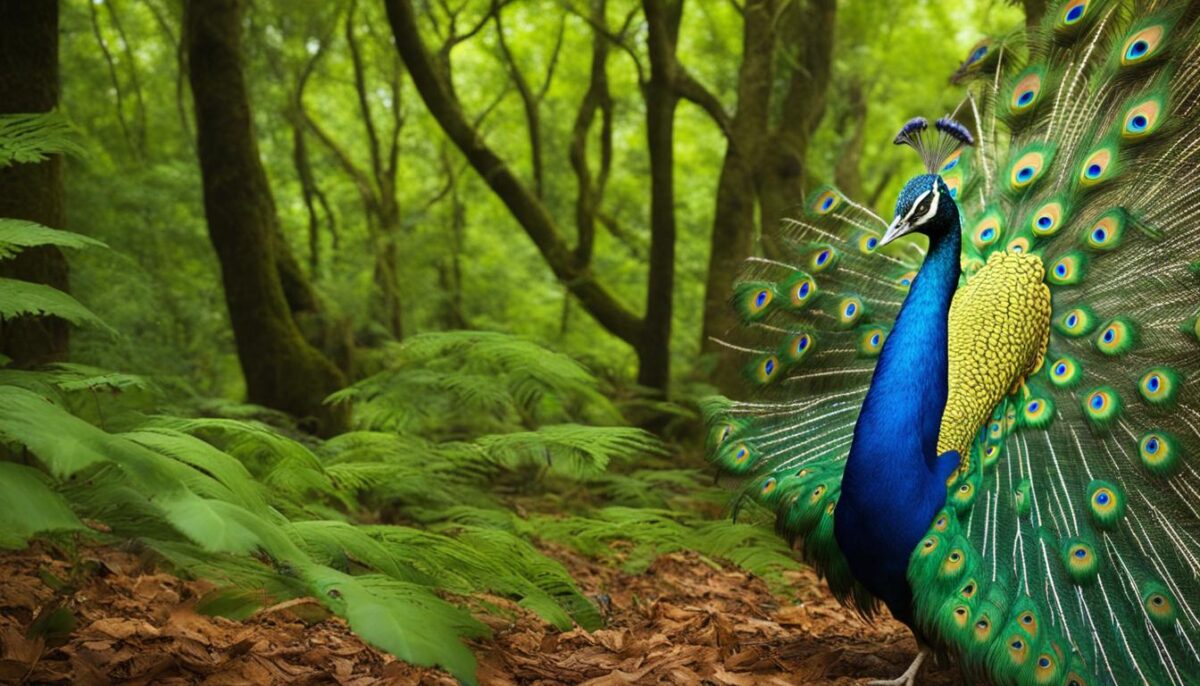
| Threats to Peacock Habitat | Conservation Solutions |
|---|---|
| Deforestation and habitat loss | Support reforestation efforts and sustainable land use practices |
| Poaching and illegal trade | Report any illegal activities and support law enforcement efforts |
| Pollution and habitat degradation | Promote and practice responsible waste disposal and pollution reduction |
| Invasive species | Control and manage invasive species to minimize their impact on peacock habitats |
| Climate change | Advocate for sustainable practices to mitigate the effects of climate change |
Conclusion
Baby male peacocks are truly fascinating creatures that captivate us with their vibrant colors, unique behaviors, and rich symbolic meaning. By delving into their growth process, understanding their care requirements, and appreciating their cultural significance, we can deepen our connection with these magnificent birds.
From their extravagant courtship displays to their regal feathers, baby male peacocks continue to mesmerize and remind us of the wonders of the natural world. Their growth journey, spanning from hatching to maturity, is a testament to the beauty and resilience of these creatures.
As we embark on this enchanting journey, let us embrace the beauty and splendor that baby male peacocks bring to our lives. By respecting and appreciating these birds and their natural habitats, we can ensure their presence for future generations to enjoy.
FAQ
What is the growth process of a baby male peacock?
The growth process of a baby male peacock involves hatching from an egg, molting through several stages, and taking about three years to develop its vibrant feathers.
What are the unique behaviors of a baby male peacock?
Baby male peacocks exhibit behaviors such as courtship displays, fanning out their tail feathers and performing dances, as well as vocalizations like calls, screams, and songs.
What is the symbolism and meaning of peacocks?
Peacocks symbolize beauty, prosperity, protection, renewal, and are associated with various deities and belief systems in different cultures.
How should a baby male peacock be cared for?
Caring for a baby male peacock involves providing a balanced diet, a spacious and secure habitat, regular veterinary check-ups, and vaccinations to ensure their health and well-being.
What is the significance of peacock feathers in culture and art?
Peacock feathers hold cultural and artistic value, symbolizing royalty, wealth, and beauty. They have been used in various art forms and cultural ceremonies.
What are some fascinating facts about peacocks?
Peacocks are the national bird of India, can fly despite their tail feathers, have an average lifespan of about 20 years, and are omnivorous, among other interesting facts.
What is the cultural significance of peacocks in different regions?
Peacocks hold cultural significance in regions such as India, China, and Greece, representing divinity, compassion, love, and royalty, among other meanings.
How have peacocks been portrayed in art and literature?
Peacocks have inspired countless artists, writers, and poets, appearing in renowned works and symbolizing beauty, pride, and transformation.
How should a respectful approach be maintained towards peacocks and their habitat?
To respect peacocks and their habitat, it is important to avoid disturbing or feeding wild peacocks, be mindful of their nesting areas, and support conservation efforts.


